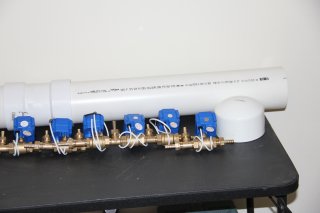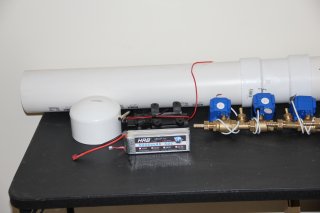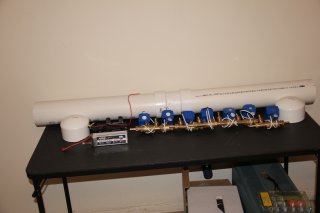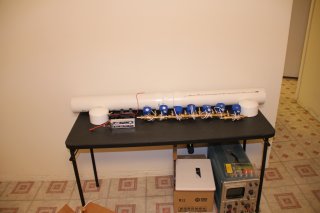RC Submarine project overview
Jul 12, 2013 @ 2:42pm
I decided to build a remote controlled submarine out of PVC pipe, RC car parts, and a raspberry pi. Initial goals were to act mostly like an RC boat on the surface, and be able to dive autonomously and return video. Total cost as of today is about $1k, though I plan on updating that and keeping an accurate count of things.
With the above goals in mind, the design I settled on was 4" PVC pipe, a conning tower would be a T section of pipe, and I would have two internal ballast tanks with a pump to move the water around and enough valves to control that. The raspberry pi would need to need to run off the RC battery, be able to control every mechanical thing I had on board, and navigate (underwater, I can't see it and I lose radio contact, it needs to operate without radio contact, and be able to come back to an area where it can get radio contact). For a depth I wanted 100 feet, so every part that might see the pressure is rated for it (100 feet of water is roughly 60psi). That's how it started anyways.
I decided to put a HD video camera on the submarine, with the some lights to allow it to see in murky waters a bit better (or at night I suppose). I picked WiFi for the radio portion since that's the cheapest option and supports more bandwidth than the RC solutions, allowing the video to be streamed over the WiFi. I also bought a long piece of Ethernet cable to act as a tether and a safety device allowing me to retrieve it if problems happened during testing.
After I figured out what I wanted I bought most of the parts, the parts list is below (as of now), and I started the electronics design portion while most of the mechanical portions were shipping from china (it took 2 months for some things). When the items arrived I did a quick mock up as shown below, put the valves in, and that's about where the mechanical side sites today, I need to finish the electronics portion to really test the mechanical stuff.
Part Selection
AliExpress (a kind of Chinese amazon) had some of the best prices for most of this stuff, but the shipping is SLOW.
The valves to control ballast were probably the most difficult to find, but luckily I found some 12V DC ball valves made by mi-sol, they had a 1/2" threaded pipe connector, I got those for $20/valve and they actually support bi-directional flow. The vast majority of valves I found online were solenoid valves, and turns out none of those will actually function in the reverse direction as they use the pressure of the fluid to close. I ended up buying 10 valves, my current design is down to 7 valves, mostly because the valves are pretty big, I'd need like 8 feet of 4" PVC to fit 10 valves in it.
With the valves being the driving factor, I settled on 12V electrical system to power the bigger mechanical things, that got me to a 14.8V RC LiPo (4S/5Ah), and I was able to easily find a 12V pump that could his 80psi (meant for paint sprayers). The pump took 3/8" tubing, so that's what I ran between ballast tanks, pumps, and valves, I needed various Ts and adapters from 3/8" barbed to 1/2" threaded. I connected the valves to the pump in a way that allows the flow to be reversed despite the fact that the pump only pumps in one direction.
The Raspberry Pi and RC servos are all 5V devices, so I needed a 5V supply as well as the 12V, I ended up designing my own power supply (covered in another post). I will say that I designed the power supply to also run off an AC adapter, and I picked the same AC adapter that my batter charger required (to make it easy). The AC adapter doesn't meet the power requirements, but at 60W it's enough to do most testing. Interfacing the raspberry pi also required lots of electronics, and I found that I could just design that as well, this helps a lot in meeting the large power requirements of many of the components and the massive amount of components I need to connect to the raspberry pi. Designing it myself meant I could also make sure the parts fit in the 4" PVC.
The PVC, and much of the larger parts for connecting to PVC were bought from my local home depot. Hobby King turned out to be great for RC parts, and I got my hull penatrators from Sub Driver. The current part/price list is below.
Parts List
AliExpress:
60W AC Adaptor (for testing/development and battery charging) - $7
HD USB Webcam - $35
3x RC Rudders, ordered with some motor shaft adapters (to fit the hull penetrator) and a screw, all from the same seller, total of $70
Pipe Adapters and Pipe Ts - $65
Ethernet to WiFi Adapter - $15
Battery Charger - $20
Pump - $35
RC Motor Controller (50A ESC) - $13
RC Battery - $47
10x Electric Ball valves - $200
4x Servos - $24
HobbyKing:
810kV motor/Pushrod Boots - $45
Battery Connectors/Nuts/Bolts - $18
Home Depot:
Pipe: 4"x2'
4" cap
4" rubber cap
4" t
2"x2' (ballast)
1.5"x2' (sail)
pipe cement
6x 2" caps
1.5" cap
-------------------
$60
2x 3/8" x 10' Hose
30 Hose clamps
PVC primer
--------------------
$49
Electronics (Parts list later) - Digikey - ~$265
Electronics - Sparkfun (GPS and replace the IMU chips from DigiKey) - ~$150
Amazon:
Zipties - $6
Grease - $7
Aluminium Rods -$13
50' Ethernet Cable - $15
20x Nylon tube elbows - $13
Sub-Driver:
Screw shaft hull penetrator - $7
Rudder Hull Penetrators -$8
Total spent to date: $1,187



